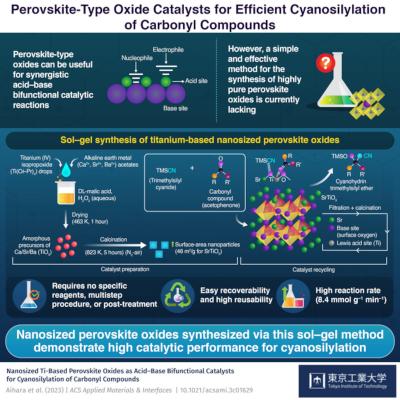Researchers from Tohoku University and Tokyo Institute of Technology (Tokyo Tech) have proposed a simple sol–gel method for the synthesis of highly pure bifunctional solid acid−base catalysts of perovskite-type oxides.
The rationale for selecting perovskite-type oxides was explained by Professor Keigo Kamata from Tokyo Institute of Technology: “Perovskite-type oxides are gaining importance in several fields, including magneticity, ferroelectricity, piezoelectricity, and catalysis. Moreover, the structure and physiochemical properties of perovskite-type oxides can be tuned by controlling their chemical composition.”
Perovskite-type oxides have a versatile composition and demonstrate good structural stability, flexibility, and controllability for several catalytic reactions. However, they have not been sufficiently explored for acid–base-catalyzed reactions. Moreover, the existing methods for synthesis are complex, time-consuming, and require multiple steps, making it difficult to synthesize highly pure and desirable perovskite oxide catalysts.
The sol–gel method developed by the team to circumvent these challenges has two key steps. The first involves preparing the precursor perovskite material, while the second comprises a calcination process to improve the surface area of the material.
To prepare the precursor, the researchers dissolved a metal alkoxide containing either titanium (Ti4+), zirconium (Zr4+), or niobium (Nb5+) cations to a solution containing malic acid and hydrogen peroxide. They then added a metal acetate containing an A-site element to the solution and dried it to form a powdered precursor.
Next, they subjected the precursor to a calcination process by heating it to 550°C in a nitrogen atmosphere and exposing it to air for 5 hours. The high temperature and the presence of oxygen crystallized the precursor and increased its surface area.
Of the various catalysts synthesized using this method, the one with SrTiO3 nanoparticles displayed the highest catalytic activity. It enabled efficient cyanosilylation of acetophenone with trimethylsilyl cyanide (TMSCN) under mild reaction conditions without any thermal pretreatment.
Upon examining the catalyst further, the team found its specific surface area (46 m2/g) to be 10 times higher than those of commercially available titanates (1–4 m2/g). Prof. Kamata adds, “We observed that the synthesized nanoparticles could activate TMSCN on the basic oxygen site and the carbonyl compound on the acidic Ti site. This cooperative activation mechanism was responsible for the high catalytic activity of the catalyst for the cyanosilylation reaction.”
The team's straightforward method for synthesizing highly pure perovskite oxides for catalysis could become a promising strategy for enabling reactions requiring mild conditions.




